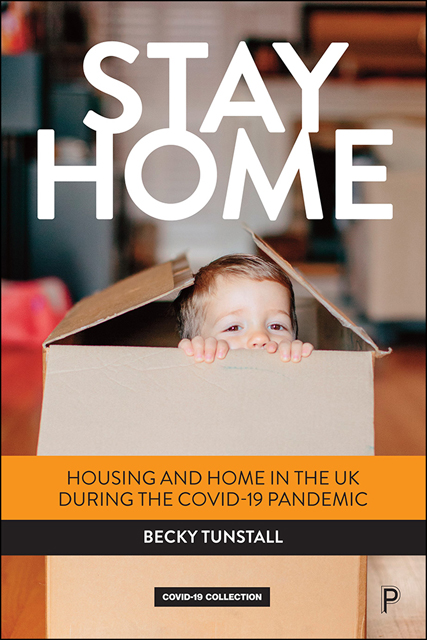Book contents
- Frontmatter
- Contents
- List of figures, tables and photos
- Acknowledgements
- 1 COVID-19, housing and home
- 2 UK households and homes before the pandemic
- 3 The pandemic and pandemic policy in the UK
- 4 People, households and time at home in the pandemic
- 5 The role of household and home in COVID-19 infection and death
- 6 Being vulnerable or ill at home in the pandemic
- 7 The impact of COVID-19 and COVID-19 policy on incomes, housing costs and housing security
- 8 The impact of COVID-19 and COVID-19 policy on the housing market
- 9 Summary and conclusions
- Appendix: The data from people aged 19, 31, 50, 62 and 74
- Notes
- References
- Index
8 - The impact of COVID-19 and COVID-19 policy on the housing market
Published online by Cambridge University Press: 20 June 2023
- Frontmatter
- Contents
- List of figures, tables and photos
- Acknowledgements
- 1 COVID-19, housing and home
- 2 UK households and homes before the pandemic
- 3 The pandemic and pandemic policy in the UK
- 4 People, households and time at home in the pandemic
- 5 The role of household and home in COVID-19 infection and death
- 6 Being vulnerable or ill at home in the pandemic
- 7 The impact of COVID-19 and COVID-19 policy on incomes, housing costs and housing security
- 8 The impact of COVID-19 and COVID-19 policy on the housing market
- 9 Summary and conclusions
- Appendix: The data from people aged 19, 31, 50, 62 and 74
- Notes
- References
- Index
Summary
Introduction
This chapter describes UK and national government policies to mitigate the impact of pandemic restrictions on the housing market, and how they worked. Policy was driven by the idea that the housing market could be used to combat pandemic unemployment and recession. In contrast to other aspects of the housing system and the economy, the housing market appeared relatively untroubled by the pandemic shock, and even flourished. This was opposite to predictions, and has been described as ‘uncanny’ and ‘unprecedented’. Housebuilding and home letting and sales had particularly short shutdowns, and returned to normal levels of activity before the end of 2020. However, in another interpretation, policy and market reactions in the pandemic were only a ‘solidification’ of pre-pandemic policies and markets: low interest rates, high demand for housing and rising prices, in the UK and across Europe. The housing market was able to help and benefit those who did well despite the pandemic: with stable incomes, and growing savings and equity, but overall the pandemic housing market increased inequality in wealth.
Supply
A small decline in construction of new homes
Construction work ceased in the UK on 23 March 2020 at the start of the first lockdown, but in England, it restarted from 13 May 2020, after just seven weeks, as long as sites could be ‘Covid-secure’. It emerged that housebuilding posed less risk of transmission than many other occupations (see Table 3.1), but nonetheless its early reopening demonstrates the salience of housebuilding to the UK government. Many companies started work, with some adaptation to distancing guidelines. Total investment in construction and repair rebounded in mid-2000 and remained ‘strong’ in 2021.
Housing starts and competitions in England fell January– March 2020 and dropped dramatically April– June 2020, but by July– September 2020, both starts and completions were slightly above pre-COVID-19 levels. Construction work continued during the second and third lockdowns. In 2019/20, 243,000 net additional homes were built or converted in England,6 but over 2020/21, the first year of the pandemic, the number of net additional homes built or converted in England reduced from 243,000 to 217,000, or by 11%.
- Type
- Chapter
- Information
- Stay HomeHousing and Home in the UK during the COVID-19 Pandemic, pp. 168 - 176Publisher: Bristol University PressPrint publication year: 2022



